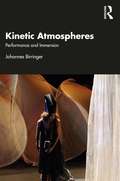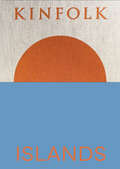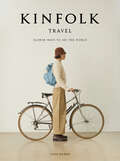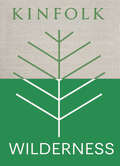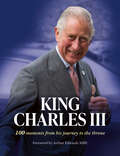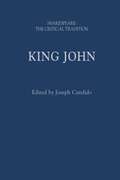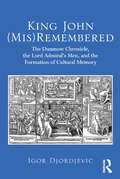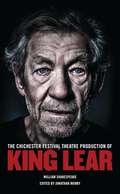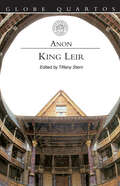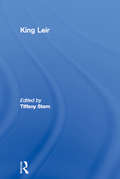- Table View
- List View
Kinderzeichnungen in der qualitativen Forschung: Herangehensweisen, Potenziale, Grenzen
by Mirja Kekeritz Melanie KubandtZiel des Sammelbandes ist es, den Gegenstand Kinderzeichnung im Rahmen der qualitativen Forschung stärker zu konturieren, die Spezifik und Eigenständigkeit der Datensorte Kinderzeichnung und deren empirischen Mehrwert an exemplarischen Forschungsprojekten aufzuzeigen und darüber hinaus mögliche Analyse- und Interpretationswege darzulegen.Im Band erfolgt sowohl eine Systematisierung unterschiedlichster erkenntnistheoretischer Perspektiven als auch ein Überblick über vielfältige methodische Zugänge zu Kinderzeichnungen. Auf diese Weise entsteht dahingehend eine interdisziplinäre Gesamtschau, wie und in welchen Kontexten (u.a. in der Erziehungswissenschaft, Sozialwissenschaft, Kindheitsforschung, Fachdidaktik) Kinderzeichnungen zum Gegenstand werden und welchen Potenzialen und (erkenntnistheoretischen) Grenzen hierbei begegnet wird.
Kindliche Nutzerwelten in der kulturellen Bildung
by Henning van den BrinkHenning van den Brink untersucht den Nutzen kultureller Bildung für Kinder mithilfe der sozialpädagogischen Nutzerforschung. Auf der Grundlage von Interviews mit an einem Musical-Projekt beteiligten Grundschülerinnen und -schülern arbeitet er heraus, wie sich die Kinder individuelle und kollektive Gebrauchswerte aneignen. Die Arbeit in der Gruppe und als Gruppe nimmt dabei eine Schlüsselrolle ein. Die Einbettung der künstlerischen Aktivität in ein solidarisches Gruppengeschehen eröffnet den Kindern neue Möglichkeiten für ästhetische Erfahrungen und den Aufbau von Selbstwirksamkeit. Dies geschieht häufig in Verbindung mit der Bewältigung zwischenzeitlicher Krisen, die in den selbst geschaffenen Räumen für partizipative Gestaltungs- und Aushandlungsprozesse entstehen.
Kinect in Motion – Audio and Visual Tracking by Example
by Clemente Giorio Massimo FascinariIn DetailKinect is a motion-sensing input device by Microsoft for the Xbox 360 video game console and Windows PCs. It provides capabilities to enhance human-machine interaction along with a zero-to-hero journey to engage the user in a multimodal interface dialog with your software solution.Kinect in Motion - Audio and Visual Tracking by Example guides you in developing more than five models you can use to capture gestures, movements, and voice spoken commands. The examples and the theory discussed provide you with the knowledge to let the user become a part of your application.Kinect in Motion - Audio and Visual Tracking by Example is a compact reference on how to master color, depth, skeleton, and audio data streams handled by Kinect for Windows.Starting with an introduction to Kinect and its characteristics, you will first be shown how to master the color data stream with no more than one page of lines of code. Learn how to manage the depth information and map them against the color ones. You will then learn how to define and manage gestures that enable the user to instruct the application simply by moving arms or any other type of natural action. Finally you will complete your journey through a multimodal interface, combining gestures with audio.The book will lead you through many detailed, real-world examples, and even guide you on how to test your application.ApproachThe book includes a series of step-by-step illustrated tutorials supported by detailed explanations for building a multimodal user interface based on Kinect for Windows.Who this book is forKinect in Motion - Audio and Visual Tracking by Example is great for developers new to the Kinect for Windows SDK, and who are looking to get a good grounding in how to master video and audio tracking. It’s assumed that you have some experience in C# and XAML already.
Kinematografie der Erinnerung: Band 1: Filme als kollektives Gedächtnis verstehen (Neue Perspektiven der Medienästhetik)
by Irina GradinariAnhand paradigmatischer sowjetischer, ost- und westdeutscher Filme über den Zweiten Weltkrieg, die die kollektive Gewalterfahrung und vor allem die zentralen historischen Ereignisse der jeweiligen Staaten nach 1945 verarbeiten und so entsprechend Erinnerungs- und somit Identitätspolitik medienspezifisch mitformen, erfasst der Band filmische Strategien, mit welchen Geschichte und Erinnerung gestaltet werden. Das kollektive Gedächtnis, so die zentrale These, ist genuin filmisch. Die Filme erfüllen für das kollektive Gedächtnis dabei drei wichtige Funktionen, die auch auf ästhetische Phänomene zurückzuführen sind: Sinnkonstitution, Bewältigung und Emotionalisierung. In Band 1 des zweibändigen Werkes wird die Theorie des kollektiven Gedächtnisses entworfen.
Kinematografie der Erinnerung: Band 2: Den Zweiten Weltkrieg erzählen (Neue Perspektiven der Medienästhetik)
by Irina GradinariAnhand paradigmatischer sowjetischer, ost- und westdeutscher Kriegsfilme über den Zweiten Weltkrieg, die die kollektive Gewalterfahrung und vor allem die zentralen Ereignisse der Erinnerungs- und somit Identitätspolitik jeweiliger Staaten verarbeiten, erfasst die Studie genuin filmische Strategien, mit welchen Geschichte und Erinnerung gestaltet wird. Die Filme, so die zentrale These, erfüllen für das kollektive Gedächtnis drei wichtige Funktionen, die auch auf ästhetische Phänomene zurückzuführen sind: Sinnkonstitution, Bewältigung und Emotionalisierung. Schwerpunkt von Band 2 des insgesamt zweibändigen Werkes bilden die Analysen ausgewählter Kriegsfilme aus Ost- und Westproduktionen.
Kinesthetic Spectatorship in the Theatre: Phenomenology, Cognition, Movement (Cognitive Studies in Literature and Performance)
by Stanton B. Garner, Jr.This book is about the centrality of movement, movement perception, and kinesthetic experience to theatrical spectatorship. Drawing upon phenomenological accounts of movement experience and the insights of cognitive science, neuroscience, acting theory, dance theory, philosophy of mind, and linguistics, it considers how we inhabit the movements of others and how these movements inhabit us. Individual chapters explore the dynamics of movement and animation, action and intentionality, kinesthetic resonance (or mirroring), language, speech, and empathy. In one of its most important contributions to the study of theatre, performance, and spectatorship, this book foregrounds otherness, divergence, and disability in its account of movement perception. The discussions of this and other issues are accompanied by detailed analysis of theatre, puppetry, and dance performances.
Kinetic Atmospheres: Performance and Immersion
by Johannes BirringerThis book offers a sustained and deeply experiential pragmatic study of performance environments, here defined at unstable, emerging, and multisensational atmospheres, open to interactions and travels in augmented virtualities. Birringer’s writings challenge common assumptions about embodiment and the digital, exploring and refining artistic research into physical movement behavior, gesture, sensing perception, cognition, and trans-sensory hallucination. If landscapes are autobiographical, and atmospheres prompt us to enter blurred lines of a "forest knowledge," where light, shade, and darkness entangle us in foraging mediations of contaminated diversity, then such sensitization to elemental environments requires a focus on processual interaction. Provocative chapters probe various types of performance scenarios and immersive architectures of the real and the virtual. They break new ground in analyzing an extended choreographic – the building of hypersensorial scenographies that include a range of materialities as well as bodily and metabodily presences. Foregrounding his notion of kinetic atmospheres, the author intimates a technosomatic theory of dance, performance, and ritual processes, while engaging in a vivid cross-cultural dialogue with some of the leading digital and theatrical artists worldwide. This poetic meditation will be of great interest to students and scholars in theatre, performing arts as well as media arts practitioners, composers, programmers, and designers.
Kinetic Atmospheres: Performance and Immersion
by Johannes BirringerThis book offers a sustained and deeply experiential pragmatic study of performance environments, here defined at unstable, emerging, and multisensational atmospheres, open to interactions and travels in augmented virtualities. Birringer’s writings challenge common assumptions about embodiment and the digital, exploring and refining artistic research into physical movement behavior, gesture, sensing perception, cognition, and trans-sensory hallucination. If landscapes are autobiographical, and atmospheres prompt us to enter blurred lines of a "forest knowledge," where light, shade, and darkness entangle us in foraging mediations of contaminated diversity, then such sensitization to elemental environments requires a focus on processual interaction. Provocative chapters probe various types of performance scenarios and immersive architectures of the real and the virtual. They break new ground in analyzing an extended choreographic – the building of hypersensorial scenographies that include a range of materialities as well as bodily and metabodily presences. Foregrounding his notion of kinetic atmospheres, the author intimates a technosomatic theory of dance, performance, and ritual processes, while engaging in a vivid cross-cultural dialogue with some of the leading digital and theatrical artists worldwide. This poetic meditation will be of great interest to students and scholars in theatre, performing arts as well as media arts practitioners, composers, programmers, and designers.
The Kinfolk Home: Interiors for Slow Living (Kinfolk)
by Nathan WilliamsA follow-up to the widely popular The Kinfolk Table, this time focusing on interior design and the trend of cultivating a more intentional, more intimate home
Kinfolk Islands (Kinfolk Adventures)
by John Burns&“Wanderlust inspiration.&”—GQ, The Best Gifts for Coworkers Join Kinfolk on a journey off the beaten track, to islands big and small, in this collection of eighteen new travel stories. Whether it&’s a tour of the otherworldly landscape of Socotra in Yemen or a hike into the old growth of a Japanese forest on Yakushima, each slow travel itinerary invites you to set sail at a pace that allows for true discovery and immersion. Filled with ideas and inspiration for where to escape, explore and unwind, Kinfolk Islands is full of vibrant photography, practical guidance and thoughtful reflections on why the idea of an island embodies so many of our travel fantasies. There are the charms of urban islands, including Montréal&’s beloved Mile End neighborhood. Truly unexpected destinations, like Hormuz, off the coast of Iran, with its psychedelic scenery and bohemian spirit. Italy&’s sun-soaked Ponza, perfect for languid afternoons. And of course some of the world&’s most beautiful beaches, from jungle-fringed Caribbean sands to rugged and remote Nordic shores. Believing that travel is as much a state of mind as an action or itinerary, Kinfolk celebrates a way of exploring our world that not only fosters thoughtful perspectives on the places we visit but also deepens our relationship with home once the journey is over.
Kinfolk Travel: Slower Ways to See the World (Kinfolk)
by John BurnsThe next book in the highly successful Kinfolk series, exploring the art of travel across five continents.
Kinfolk Wilderness (Kinfolk Adventures)
by John BurnsThe second volume in the new Kinfolk trilogy (following Kinfolk Islands), which invites readers to celebrate the beauty and possibility to be found in the great outdoors.
King and Collector: Henry VIII and the Art of Kingship
by Linda Collins Siobhan ClarkeNo English king is as well-known to us as Henry VIII: famous for six marriages; for dissolving the monasteries; and for the ruthless destruction of those who stood in his way. But Henry was also an ardent patron of the arts whose tapestries and paintings, purchased in pursuit of glory and magnificence, adorned his lavish court and began the Royal Collection. In contrast to later royal collectors, this king was more interested in storytelling than art for its own sake, and all his commissions relate to one central tale: the glorification of Henry and his realm. His life can be seen through his art collection and the works tell us much about both his kingship and his insecurities. King and Collector tells a unique story of art, power and propaganda in Tudor England.
The King and I (Shakespeare Now!)
by Philippa KellyA unique exploration of Shakespeare's King Lear, with its themes of banishment, alienation and hope, via a personal memoir that embraces the history of Australia.
The King and I (Shakespeare Now!)
by Philippa KellyA unique exploration of Shakespeare's King Lear, with its themes of banishment, alienation and hope, via a personal memoir that embraces the history of Australia.
King Charles III: 100 Moments From His Journey To The Throne
by The SunStunning, photographic King Charles III memorabilia gift for royal fans As the nation celebrates the coronation of a new monarch, The Sun looks back on 100 moments in the life of the man who would be king.
King David, Man of Blood (Oberon Modern Plays)
by Fraser GraceLucifer makes a wager with God and sets out to test the loyalty of his favourite son, King David, Man of Blood. David's eyes are opened and for the first time he glimpses the demon inside his own god-like being. Now David must question the nature of a God who continues to bless him, a 'war criminal' in all he does. What does this say about the God he worships? David determines to set God a test of his own. Seducing the beautiful Bethsebe and sending her husband Uriah back to the front with sealed orders, David inches his way toward a crime any good God must surely punish. Mustn't he? In the battle between heaven and earth which ensues, the innocent quickly fall and David's challenge to God assumes cataclysmic proportions... King David, Man of Blood re-spins a classic biblical tale to devastating moral effect, fetching up on a very modern shore, where horror, tragedy, comedy and a terrible beauty co-exist.
King John: Shakespeare: The Critical Tradition (Shakespeare: The Critical Tradition)
by Joseph CandidoThis new volume in Shakespeare: The Critical Tradition increases our knowledge of how Shakespeare's plays were received and understood by critics, editors and general readers. Updated with a new introduction providing a survey of critical responses to the plays since the late 1930s to the present day, the volume offers, in separate sections, both critical opinions about the play across the centuries and an evaluation of their positions within and their impact on the reception of the play. The chronological arrangement of the text-excerpts engages the readers in a direct and unbiased dialogue, whereas the introduction offers a critical evaluation from a current stance, including modern theories and methods. Thus the volume makes a major contribution to our understanding of the play and of the traditions of Shakespearean criticism surrounding it as they have developed from century to century.
King John: Shakespeare: The Critical Tradition (Shakespeare: The Critical Tradition)
This new volume in Shakespeare: The Critical Tradition increases our knowledge of how Shakespeare's plays were received and understood by critics, editors and general readers. Updated with a new introduction providing a survey of critical responses to the plays since the late 1930s to the present day, the volume offers, in separate sections, both critical opinions about the play across the centuries and an evaluation of their positions within and their impact on the reception of the play. The chronological arrangement of the text-excerpts engages the readers in a direct and unbiased dialogue, whereas the introduction offers a critical evaluation from a current stance, including modern theories and methods. Thus the volume makes a major contribution to our understanding of the play and of the traditions of Shakespearean criticism surrounding it as they have developed from century to century.
King John (Mis)Remembered
by Igor DjordjevicKing John’s evil reputation has outlasted and proved more enduring than that of Richard III, whose notoriety seemed ensured thanks to Shakespeare’s portrayal of him. The paradox is even greater when we realize that this portrait of John endures despite Shakespeare’s portrait of him in the play King John, where he hardly comes off as a villain at all. Here Igor Djordjevic argues that the story of John’s transformation in cultural memory has never been told completely, perhaps because the crucial moment in John’s change back to villainy is a literary one: it occurs at the point when the 'historiographic' trajectory of John’s character-development intersects with the 'literary' evolution of Robin Hood. But as Djordjevic reveals, John’s second fall in cultural memory became irredeemable as the largely unintended result of the work of three men - John Stow, Michael Drayton, Anthony Munday - who knew each other and who all read a significant passage in a little known book (the Chronicle of Dunmow), while a fourth man’s money (Philip Henslowe) helped move the story from page to stage. The rest, as they say, is history. Paying particular attention to the work of Michael Drayton and Anthony Munday who wrote for the Lord Admiral’s Men, Djordjevic traces the cultural ripples their works created until the end of the seventeenth century, in various familiar as well as previously ignored historical, poetic, and dramatic works by numerous authors. Djordjevic’s analysis of the playtexts’ source, and the personal and working relationship between the playwright-poets and John Stow as the antiquarian disseminator of the source text, sheds a brighter light on a moment that proves to have a greater significance outside theatrical history; it has profound repercussions for literary history and a nation’s cultural memory.
King John (Mis)Remembered: The Dunmow Chronicle, The Lord Admiral's Men, And The Formation Of Cultural Memory
by Igor DjordjevicKing John’s evil reputation has outlasted and proved more enduring than that of Richard III, whose notoriety seemed ensured thanks to Shakespeare’s portrayal of him. The paradox is even greater when we realize that this portrait of John endures despite Shakespeare’s portrait of him in the play King John, where he hardly comes off as a villain at all. Here Igor Djordjevic argues that the story of John’s transformation in cultural memory has never been told completely, perhaps because the crucial moment in John’s change back to villainy is a literary one: it occurs at the point when the 'historiographic' trajectory of John’s character-development intersects with the 'literary' evolution of Robin Hood. But as Djordjevic reveals, John’s second fall in cultural memory became irredeemable as the largely unintended result of the work of three men - John Stow, Michael Drayton, Anthony Munday - who knew each other and who all read a significant passage in a little known book (the Chronicle of Dunmow), while a fourth man’s money (Philip Henslowe) helped move the story from page to stage. The rest, as they say, is history. Paying particular attention to the work of Michael Drayton and Anthony Munday who wrote for the Lord Admiral’s Men, Djordjevic traces the cultural ripples their works created until the end of the seventeenth century, in various familiar as well as previously ignored historical, poetic, and dramatic works by numerous authors. Djordjevic’s analysis of the playtexts’ source, and the personal and working relationship between the playwright-poets and John Stow as the antiquarian disseminator of the source text, sheds a brighter light on a moment that proves to have a greater significance outside theatrical history; it has profound repercussions for literary history and a nation’s cultural memory.
King Lear: With An Introduction And Notes... (Oberon Classics)
by William ShakespeareJonathan Munby’s explosive revival of Shakespeare’s epic tragedy transferred to the West End following its sold-out run at Chichester Festival Theatre, performed by a celebrated cast led by Ian McKellen as the embittered monarch in a fractured kingdom. This version of the text was edited and curated specially for the production.Two ageing fathers - one a King, one his courtier - reject the children who truly love them. Their blindness unleashes a tornado of pitiless ambition and treachery as family and state are plunged into a violent power struggle with shocking ends.Tender, brutal, moving and epic, King Lear is considered by many to be the greatest tragedy ever written.
King Leir (Globe Quartos)
by AnonymousPerformed at the Globe Theater in 1605, King Leir is presumed to be a prime source for Shakespeare. Although the story is the same, in this anonymous version the ending is happy. This is the first time this fascinating work is published in a single-play edition
King Leir (Globe Quartos)
by AnonymousPerformed at the Globe Theater in 1605, King Leir is presumed to be a prime source for Shakespeare. Although the story is the same, in this anonymous version the ending is happy. This is the first time this fascinating work is published in a single-play edition
King of Bollywood: Shah Rukh Khan and the Seductive World of Indian Cinema
by Anupama ChopraHere is the astonishing true story of Bollywood, a sweeping portrait about a country finding its identity, a movie industry that changed the face of India, and one man's struggle to become a star. Shah Rukh Khan's larger than life tale takes us through the colorful and idiosyncratic Bollywood movie industry, where fantastic dreams and outrageous obsessions share the spotlight with extortion, murder, and corruption. Shah Rukh Khan broke into this $1.5 billion business despite the fact that it has always been controlled by a handful of legendary film families and sometimes funded by black market money. As a Muslim in a Hindu majority nation, exulting in classic Indian cultural values, Shah Rukh Khan has come to embody the aspirations and contradictions of a complicated culture tumbling headlong into American style capitalism. His story is the mirror to view the greater Indian story and the underbelly of the culture of Bollywood. "A bounty for cinema lovers everywhere." -- Mira Nair, Director, The Namesake and Monsoon Wedding"King of Bollywood is the all-singing, all-dancing back stage pass to Bollywood. Anupama Chopra chronicles the political and cultural story of India with finesse and insight, through fly-on-wall access to one of its biggest, most charming and charismatic stars." -- Gurinder Chadha, director of Bend it Like Beckham "The "Easy Rider Raging Bull" of the Bollywood industry and essential reading for any Shah Rukh Khan fan." --Emma Thompson, actress "Anu Chopra infuses the pivotal moments of Shah Rukh Khan's life with an edge-of-your-seat tension worthy of the best Bollywood blockbusters." -- Kirkus






